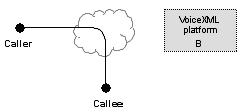
You are here: Excel CSP: VoiceXML Userís Guide†>†2 VXML Transfers†>†Blind Transfer

With a blind transfer, an attempt is made to connect the original caller with the called party. Any prompts preceding the transfer, as well as prompts within the transfer, are queued and played before the transfer attempt begins; barge-in properties apply as normal.

Figure 2-1 Audio Connections during a blind transfer: <transfer bridge="false">
Any audio source specified by the transfer audio attribute is ignored since no audio can be played from the platform to the caller during the transfer attempt. Whether the connection is successful or not, the implementation platform cannot regain control of the connections.
Connection status is not available. For example, it is not possible to know whether the called party was busy, when a successful call ends, etc. However, some error conditions may be reported if known to the platform, such as if the caller is not authorized to call the destination, or if the destination URL is malformed. These are platform-specific, but should follow the naming convention of other transfer form item variable values.
The caller can cancel the transfer attempt before the outgoing call begins by barging in with a speech or DTMF command that matches an active grammar during the playback of any queued audio.
If the caller disconnects by hanging up during a call transfer attempt before the connection to the called party begins, a connection.disconnect.hangup event will be thrown, and dialog execution will transition to a handler for the hangup event (if one exists). The form item variable, and thus shadow variables, will not be set.
Once the transfer begins and the interpreter disconnects from the session, the platform throws connection.disconnect.transfer and document interpretation continues normally.
A blind transfer from the VXML platform perspective can be bridged through the CSP or transferred by the network. In either case, the call is transferred regardless of the success of the called party (outbound) call. The TEP will send the type of transfer and the destination number to the SwitchKit call processing application. A call ID will be sent along with this information that allows the SwitchKit call processing application to identify the inbound leg for that transfer.